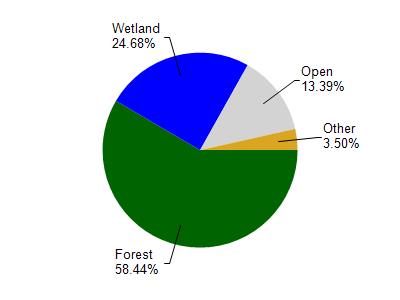Oneida
No
No
Yes
Fish and Aquatic Life
Overview
Sand Lake (Sugar Camp Chain), in the Sugar Camp Creek Watershed, is a 547.39 acre lake that falls in Oneida County. This lake is managed for fishing and swimming and is currently considered impaired.
Date 2011
Author Aquatic Biologist
Historical Description
Sand Lake, T39N, R9E, Section 20
A soft water drainage lake having slightly acid, light brown water of low transparency. Sand is the predominant littoral material (60 percent) with gravel (25 percent) and muck. The shoreline is predominantly upland (85 percent) with wetland adjoining a portion of the lake basin. Muskellunge, northern pike, walleye, largemouth bass, smallmouth bass, perch, bluegill, crappie, pumpkinseed, bullhead and suckers are found in this lake. Public access with parking is available. Four resorts, two youth camps and 24 dwellings are located on the shore. Water levels are maintained by a water control structure of six foot head located on the outlet of Dam Lake. Part of the Sugar Camp Chain.
Surface Acres = 544, S.D.F. = 1.38, Maximum Depth = 20 feet
Date
Author Surface Water Inventory Of Wisconsin
General Condition
Sand Lake (WBIC 1597000) was placed on the impaired waters list for total phosphorus in 2016 as a Two-Story Fishery Lake. Subsequently the lake has been reclassified by fisheries biologists as a Shallow Lowland Lake, not Two-Story Fishery. This changed the TP criteria used. This lake was assessed during the 2018 listing cycle; new total phosphorus and chlorophyll sample data were clearly below 2018 WisCALM listing thresholds for the Recreation use and the Fish and Aquatic Life use. This water was meeting these designated uses and not considered impaired.
Date 2017
Author Ashley Beranek
Impaired Waters
Sand Lake (1597000) was assessed during the 2016 listing cycle; new fish tissue data confirms that the statewide mercury advisory is sufficient because mercury concentrations fall in the range of the general advisory. Total phosphorus sample data overwhelmingly exceed 2016 WisCALM listing thresholds for the Recreation use and Fish and Aquatic Life use and chlorophyll data did not exceed REC and FAL thresholds.
Date 2015
Author Aaron Larson
Condition
Wisconsin has over 84,000 miles of streams, 15,000 lakes and milllions of acres of wetlands. Assessing the condition of this vast amount of water is challenging. The state's water monitoring program uses a media-based, cross-program approach to analyze water condition. An updated monitoring strategy (2015-2020) is now available. Compliance with Clean Water Act fishable, swimmable standards are located in the Executive Summary of Water Condition in 2018. See also the 'monitoring and projects' tab.
Reports
Management Goals
Wisconsin's Water Quality Standards provide qualitative and quantitative goals for waters that are protective of Fishable, Swimmable conditions [Learn more]. Waters that do not meet water quality standards are considered impaired and restoration actions are planned and carried out until the water is once again fishable and swimmable
Management goals can include creation or implementation of a Total Maximum Daily Load analysis, a Nine Key Element Plan, or other restoration work, education and outreach and more. If specific recommendations exist for this water, they will be displayed below online.
Monitoring
Monitoring the condition of a river, stream, or lake includes gathering physical, chemical, biological, and habitat data. Comprehensive studies often gather all these parameters in great detail, while lighter assessment events will involve sampling physical, chemical and biological data such as macroinvertebrates. Aquatic macroinvertebrates and fish communities integrate watershed or catchment condition, providing great insight into overall ecosystem health. Chemical and habitat parameters tell researchers more about human induced problems including contaminated runoff, point source dischargers, or habitat issues that foster or limit the potential of aquatic communities to thrive in a given area. Wisconsin's Water Monitoring Strategy was recenty updated.
Grants and Management Projects
Monitoring Projects
| WBIC | Official Waterbody Name | Station ID | Station Name | Earliest Fieldwork Date | Latest Fieldwork Date | View Station | View Data |
|---|
| 1596700 | Sugar Camp Creek | 443524 | Sugar Camp Creek at Cth-D Bridge | | | Map | Data |
| 1597000 | Sand Lake | 444026 | Sand Lake (T39r9s20) - Sand Lake (T39r9s20) | 8/23/1979 | 8/23/1979 | Map | Data |
| 1597000 | Sand Lake | 10001449 | Sand Lake | 7/27/1999 | 9/30/2017 | Map | Data |
| 1597000 | Sand Lake | 443248 | Sand Lake - Deep Hole | 9/5/1979 | 10/18/2022 | Map | Data |
| 1597000 | Sand Lake | 10021038 | Sand Lake At Boat Landing Off Of Hwy D. | 7/25/1997 | 7/7/2023 | Map | Data |
| 1597000 | Sand Lake | 10043527 | Sand/Dam Lake Boat Launch off Cth D | 7/24/2014 | 7/20/2022 | Map | Data |
|

Watershed Characteristics
Sand Lake is located in the Sugar Camp Creek watershed which is 187.99 mi². Land use in the watershed is primarily forest (58.50%), wetland (24.70%) and a mix of open (13.40%) and other uses (3.50%). This watershed has 123.61 stream miles, 11,669.73 lake acres and 30,139.17 wetland acres.
Nonpoint Source Characteristics
This watershed is ranked Not Ranked for runoff impacts on streams, Medium for runoff impacts on lakes and Low for runoff impacts on groundwater and therefore has an overall rank of Low. This value can be used in ranking the watershed or individual waterbodies for grant funding under state and county programs.However, all waters are affected by diffuse pollutant sources regardless of initial water quality. Applications for specific runoff projects under state or county grant programs may be pursued. For more information, go to surface water program grants.